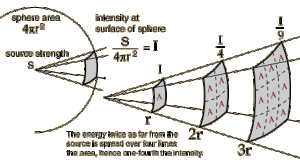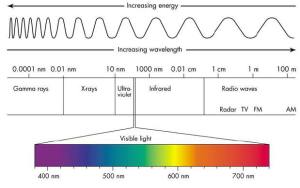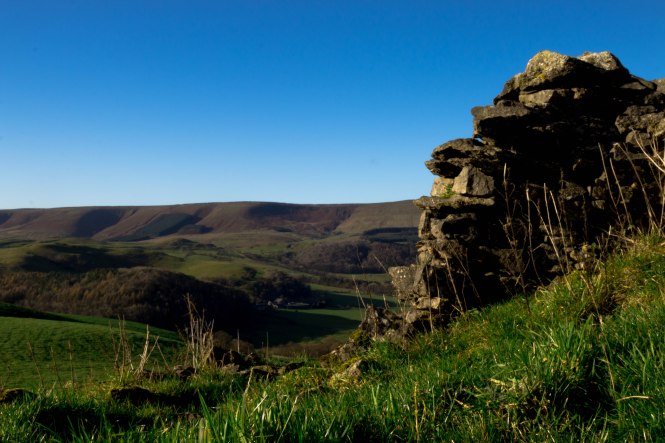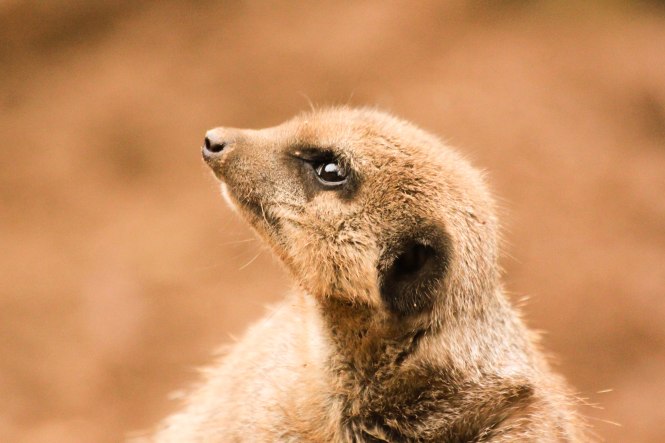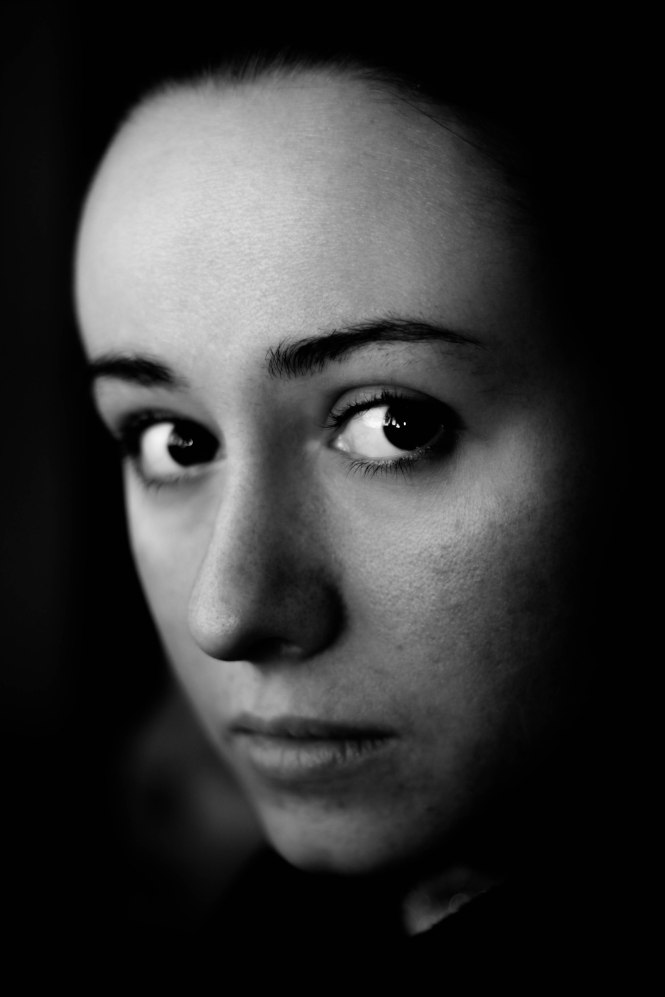The inverse square law is the intensity of light from a constant source falls off as the square of the distance from the source. Any light source that spreads light in all directions, i.e. a lightbulb obeys this law. If you were to walk away from a campfire in the middle of a dark woods, it would get dark pretty quickly. Basically, the double the distance you are from the light, you quarter the light intensity. The light falls off 1 over the distance multiplied by itself. The light measured at 2 metres from the source will be half squared the intensity, if it was one meter it would be a quarter of the intensity. a light measured 4 metres from the same source would be a quarter squared or a sixteenth the intensity at one metre. In photography, as every stop means halving or doubling the light, a quarter of the light is two stops down and a 16th of the light is four stops down. A light reading of f/16 at 1 metre, for example would be f/8 at 2 metres and f/4 at 4 metres. The only light source that conflicts with this law is the sun, as the distance we move something on earth is quite trivial in comparison to the distance between the earth to the sun.
Month: November 2014
What is Light?
Light is a gift in some photographic moments, and when light is presented, you must make the best of what you have. However, in the studio, you have full control of the light. I am researching the simple rules and guidelines to improvise my lighting skills and have a better understanding of the aesthetics I can achieve in the studio. I would rather learn from my mistakes, learn from lectures or even books and the internet than have poor quality lighting and ruining my images. Before taking my images or even brainstorming ideas, I feel that I need to understand lighting and build a relationship with it. Understanding the simplest of qualities, will help me understand how to bring out shadows, highlights, detail and saturation. I have chosen three books and various websites to give me the tools to develop my studio skills. As I am aware of photographic lighting, I have no real experience, though I have worked with lighting in moving image. This kind of lighting however, is different.
What is lighting?
Scientifically, light is a narrow band of electromagnetic radiation, we can see it because the optic nerves are sensitive to these bands of radiation. There are no accurate boundaries to the range in which we can see light as individuals are different, but on average our eyes are receptive to a range of wavelengths between 400 – 700 nanometers.
Radient energy exists above and below the visible spectrum of light. Above the visible spectrum is ultraviolet and below is infrared. The digital revolution has allowed us to use technology such as photography and film, to pick up these colours and and convert them into a range of visibility.
The Electromagnetic Spectrum
Photographers are typically interested in three physical properties of lighting – The wavelength/Frequency, the amplitude/intensity and the angle of vibration/polarization. The intensity of the light determines the brightness, the wavelength determines the colour and the changes of polarization are barely visible to the human eye, however these can be manipulated using polarizing filters.
Light causes shadows because it travels in straight lines, it is then reflected off a shiny surface like a mirror that reverses the angle of which the light falls. These simple laws allow the photographer to manipulate light to their advantage, using reflectors, mirrors and cutters. Light can also be refracted, meaning lenses can be designed to focus an image.
Light allows us to see colour, without it, the world would be colourless. For example, a green pepper only looks green if the corresponding wavelengths are present in the illuminating light. If an orange light that contains no green, falls over a green pepper, the pepper would appear grey and colourless.
Light that contains all the colors of the spectrum is known as daylight, but photographers use this term precisely. White light comes from radiating sources, the sun, lightbulbs, flash guns etc. However there is some underlining connection with heat. Photographers use the theory of colour temperature, the theory wavelengths on the spectrum heating up to describe the exact colour of a lightsorce (tungsten, florescent etc.)
The Nomograph
A Vase of Flowers – Photograph Four
Camera: Canon 500D
Focal Length: 18-55mm (42.0mm)
ISO: 100
Shutter Speed: 1/250
Aperture: f/10.0
This is one of my favourite photographs from the module. I love how weird and wacky this photograph is and I feel that it is aesthetically beautiful. The subject matter was chosen due to how similar the photographs from previous years were. Although they were all different, the subject matter was the same. I chose this fox as my vase because I believe that all life is as important as the next. I also believe that it is fundamentally important that I spread this message in my photography. People seem to treat animals as objects and this is what I am trying to show. The contrast between faux flowers and the fox creates significant meaning. Though many people would see the fox as fake, it’s not. Or at least it wasn’t at one time. The flowers are not real and lack life, but the flowers didn’t have their lives taken from them. The fox however, did. The fact that this poor animal lost its life so that someone could mount it and use it as a decoration, is wrong.
To achieve this image, I pumped the ISO right down to 100 to maintain a sharp image with no noise. I used my kit lens (18-55mm) as I was quite close to the fox and I was uninterested in depth of field. I set my aperture at f/10.0 in order to keep it all in pin sharp focus, and the shutter speed is at 250th of a second to expose the image correctly. This image was also taken handheld, so a fast shutter speed allowed me to take the image with no camera shake. I achieved the exposure and lighting using my speedlite. I pointed the flash slightly above the frame allowing me to light one side of the fox’s face. This photograph allowed me to explore photography as a way to create meaning and express myself. This project allowed me to think outside the box and create something totally different.
Curriculum Vitae
Curriculum Vitae
James Telford
12 Address Street, Earth
Tel: xxxxx xxxxxx
Mob: xxxxxxxxxxx
EmailAddress@email.com
Personal Profile
I am an enthusiastic and creatively driven individual, with a work ethic that is second to none. I am currently studying a BA in photographic media with the aspiration to one day be a freelance film maker or photographer. I currently work at ASDA in Accrington as a sales assistant, but looking for work closer to University. I have experience with tills, customer services, stocking shelves, warehouse and working with produce. As a film maker and photographer I have gained leadership skills, communication skills, technical skills and I am able to work well in a team. All of these skills are easily transferable in a retail environment.
Education and Qualifications
2005-2010 Army Cadet Force
- Duke of Edinburgh Award (Silver)
- SCIC (Senior Cadet Instructor Cadre)
- BTEC 1st Diploma – Public Services
2003-2008 Rhyddings Business And Enterprise School
| Subject | Grade |
| Mathematics | C |
| English Literature | C |
| English Language | C |
| ICT | C |
| Business Studies | D |
| Product Design | D |
| History | F |
| Science | D |
2008-2011 Blackburn College
- Auto Electrical IMI Level 1
- Key Skills (English)
- National Certificate – Creative Computing: Merit
- National Diploma – Media Production: DDM
2013-2014 Blackburn College
- UAL Foundation – Art & Design: Pass
Work Experience
2010-2010 FCBetz
Betting Cashier – Taking bets at football games.
I gained financial skills and was trained on a till.
2010-2011 Home Bargains
Retail Assistant – Stocking the shelves and checkout.
I was till trained and gained retail skills.
2013- ASDA
Sales Assistant – Anything from checkouts to customer
services.
Skills
- Leadership
- Team Work
- ICT Skills
- First Aid
- Problem Solving
- Communication
- Customer Service
- Till Trained
- Creative
Interests and Activities
I am extremely passionate about the arts. This can be anything between; film, television, photography, fine art and writing. I have wrote, directed and published my own films and have also been involved with photographing events in my spare time. It’s not only a career aspiration, it’s also my hobby. Any other spare time I have I play video games, listen to music, write poetry and write short stories. I also enjoy playing my guitar.
Large Depth of Field Landscape – Photo Three
Camera: Canon 500D
Focal Length: 20mm
ISO: 100
Shutter Speed: 10
Aperture: f/8
I really dislike this photograph, it reminds me of how disappointing this night was. My first aim was to capture the light streams of the Blackpool wheel on the north promenade. However, none of the lights were on. So I decided to pay around and try to capture something to show on peer assessment day. I feel though my photo is aesthetically terrible, I think I executed the technique rather well. I used a wide angle lens (20mm), I had a low ISO and a slow shutter speed. I also used a larger aperture to compensate the shutter speed. I did learn a lot from this photo, and most importantly I learned that photography can be quite unexpectedly disappointing. Peer assessment didn’t really go very well, not just for me, but for most. Only a few managed to use hyper-focal distancing correctly. We were given the chance to reshoot and things turned out much better.
Camera: Canon 500D
Focal Length: 24mm
ISO: 100
Shutter Speed: 1/40
Aperture: f/22
I like this a lot more. I feel like I accomplished something in terms of aesthetics. This photograph was taken in the Trough of Bowland in the Ribble Valley. I looked back at my hyper-focal distance lecture notes and came prepared this time. I would have used a wider angle lens, but 24mm was the only one available. My ISO was pumped right down to 100, in order to achieve a pin sharp image. My aperture was set to f/22 in order to achieve a greater depth of field, allowing everything to be in pin sharp focus. And my shutter speed was set to 1/40 in order to expose my image correctly. I of course used a tripod for this image as my shutter speed is under 1/60. The use of a tripod, a bag of heavy stones and a shutter release remote allowed me to take the image with no risk of camera shake. I used the 24mm to focus hyper-focally without visually focusing as the brief tasked me to do. I chose this location due to the wall being in the foreground, the house in the mid-ground and the hills in the background. I chose the time of day at around 3:30pm as it was winter and would get dark early. My aim was to capture the light as the sun was setting, though I arrived a bit early and had to leave before the beautiful tungsten glow.
Shallow Depth of Field Portrait – Photograph Two
Camera: Canon 500D
Focal Length: 75-300mm (300mm)
ISO: 3200
Shutter Speed: 1000/1
Aperture: f/7.1
This portrait I had taken at Chester Zoo was taken on Shutter Priority. I wanted to explore the other features of my camera in order to gain more experience, knowledge and confidence when using my DSLR. I really like a lot about this photograph, I really enjoy photographing animals, in fact it is becoming somewhat of a passion thanks to Sebastio Salgado and his Genesis project. I love to photograph animals because of their innocence, and their lack of a voice, I really feel like this photograph captures this. His eyes for me, provoke an extreme amount of emotion and the way the light illuminates the shape of his body definitely adds to this.
When I positioned the frame for this photograph, I had to be extremely quick due to meerkats moving around pretty much all the time. This is why I chose to use shutter priority. I wanted to capture the animals looking vulnerable as part of an ongoing project of mine and to do so, I felt that the shutter speed was the most important. I selected a fast shutter speed which in this case was 1000/1. I know now that this is rather an unnecessary speed, but at the time I was still learning how to use my camera. Due to my choosing of shutter priority, the camera selected the aperture for me. In this case, f/7.1. This being due to my focal length of 300mm. The aperture was about half open, allowing a beautiful shallow depth of field. The ISO was pumped right up to counteract the shutterspeed, giving me just enough light to correctly expose the photograph. Although, due to the high ISO, there is quite a lot of noise, but I feel as though it works well in this instance.
After a peer assessment, I was told that my photograph was a photograph of a Meerkat and not about a Meerkat, I would have to disagree, due to my own emotional response, but I am happy to take any criticism. So I reshot my Shallow Depth of Field Portrait.
Camera: Canon 500D
Focal Length: 50mm
ISO: 100
Shutter Speed: 1/200
Aperture: f/1.8
Although I really like my Meerkat photo, I believe that this photo meets the brief much better. As you can see from my settings, my understanding of how to use a camera has drastically changed. I used a 50mm f/1.8 to achieve my shallow depth of field, I framed the shot quite beautifully, the light was achieved using a flashgun which compensated my fast shutter and my low ISO. I chose black and white for this photo because as I have grown as a photographer, I believe that black and white portraits bring out the soul, especially in the subjects eyes.

